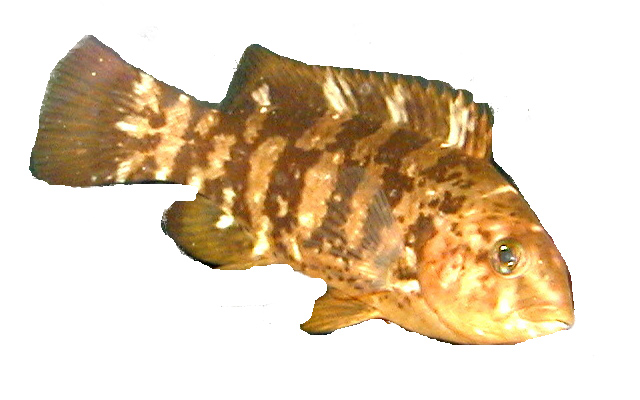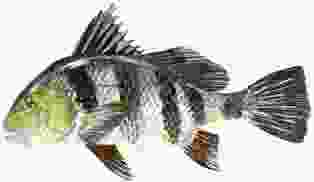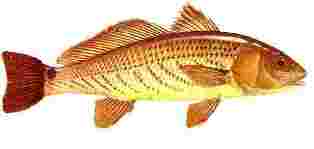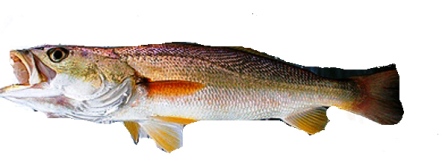Discover Florida Nature
It's time to explore the natural Florida


|
|
|
|
|
 Atlantic
Croaker
(Micropogonias undulatus) Atlantic croaker "croak" by
vibrating their swim bladders with special muscles as part of their
spawning ritual. A swim bladder is a pocket full of air inside the fish
that helps keep it afloat and facing upright. Atlantic croaker are about
12 inches long and weigh 1/2 to 2 pounds on average. Its
distinguishing characteristics include three to five pairs of small
barbels or "whiskers" on their chins to help them feel for food on the
sea floor; a lateral line that extends to the tip of its caudal (tail)
fin; inferior mouth (located to the bottom of the head facing the
ground), and brown vertical stripes on its sides. Adults are silver with
a pinkish cast, while young are silvery and iridescent. Older fish are
brassy in color with vertical brown streaks formed by spots that are on
their scales. The Atlantic croaker is found on the Atlantic coast from
Massachusetts southward and throughout the Gulf of Mexico. Atlantic
croaker prefer estuaries and bays through the spring and summer, then
travel offshore in the fall to breed. Atlantic croaker can live up to
eight years. Their predators include striped bass, shark, spotted
seatrout, other croakers, and humans. Croaker that live in the northern
part of their range mature later and live longer than those in the
southern part of their range. Atlantic
Croaker
(Micropogonias undulatus) Atlantic croaker "croak" by
vibrating their swim bladders with special muscles as part of their
spawning ritual. A swim bladder is a pocket full of air inside the fish
that helps keep it afloat and facing upright. Atlantic croaker are about
12 inches long and weigh 1/2 to 2 pounds on average. Its
distinguishing characteristics include three to five pairs of small
barbels or "whiskers" on their chins to help them feel for food on the
sea floor; a lateral line that extends to the tip of its caudal (tail)
fin; inferior mouth (located to the bottom of the head facing the
ground), and brown vertical stripes on its sides. Adults are silver with
a pinkish cast, while young are silvery and iridescent. Older fish are
brassy in color with vertical brown streaks formed by spots that are on
their scales. The Atlantic croaker is found on the Atlantic coast from
Massachusetts southward and throughout the Gulf of Mexico. Atlantic
croaker prefer estuaries and bays through the spring and summer, then
travel offshore in the fall to breed. Atlantic croaker can live up to
eight years. Their predators include striped bass, shark, spotted
seatrout, other croakers, and humans. Croaker that live in the northern
part of their range mature later and live longer than those in the
southern part of their range. Black
Drum
(Pogonias cromis) The black drum is found off the
Atlantic coast of Florida and also in the Gulf of Mexico up to Tampa Bay
especially in bays and lagoons. The black drum is the largest of the
drum family and has a high arched back with large scales. One of its
distinctive features is the 10 to 14 pairs of chin barbells. The adult
black drum has a gray or black colored body while juveniles have 4 to 6
vertical bars along their body. The juvenile fish are often mistaken for
the similar looking red drum, sheepshead, and the spadefish. One of
the attributes that black drum has in its armory is its cobblestone-like
teeth capable of crushing oysters. Juveniles normally reach 12 inches
after the first year and grow at a rate of about 2 inches per year. It
is not uncommon for these fish to reach 30 pounds and live to an age of
35 years or more although some have been found weighing 90 pounds. The
younger black drum prefer brackish waters and is often found inshore and
is quite common in bays and lagoons where they like habitats of
structure and protection. Older black drum move out to the saltier
waters of estuaries offshore. Black drum are bottom dwellers and with
its powerful jaws and teeth it is often found around oyster beds. Being
a bottom dweller it will feed on oysters, mussels, crabs, shrimp, and
occasionally fish. Being the largest member of the drum family, black
drum spawns near the shore in winter and early spring. Black
Drum
(Pogonias cromis) The black drum is found off the
Atlantic coast of Florida and also in the Gulf of Mexico up to Tampa Bay
especially in bays and lagoons. The black drum is the largest of the
drum family and has a high arched back with large scales. One of its
distinctive features is the 10 to 14 pairs of chin barbells. The adult
black drum has a gray or black colored body while juveniles have 4 to 6
vertical bars along their body. The juvenile fish are often mistaken for
the similar looking red drum, sheepshead, and the spadefish. One of
the attributes that black drum has in its armory is its cobblestone-like
teeth capable of crushing oysters. Juveniles normally reach 12 inches
after the first year and grow at a rate of about 2 inches per year. It
is not uncommon for these fish to reach 30 pounds and live to an age of
35 years or more although some have been found weighing 90 pounds. The
younger black drum prefer brackish waters and is often found inshore and
is quite common in bays and lagoons where they like habitats of
structure and protection. Older black drum move out to the saltier
waters of estuaries offshore. Black drum are bottom dwellers and with
its powerful jaws and teeth it is often found around oyster beds. Being
a bottom dweller it will feed on oysters, mussels, crabs, shrimp, and
occasionally fish. Being the largest member of the drum family, black
drum spawns near the shore in winter and early spring.  Red
Drum (redfish) (Sciaenops ocellatus) The red drum is
known under many common names such as channel bass, redfish, spottail
bass or simply as reds. The red drum is characterized by its reddish to
bronzed body which becomes white on the lower part of the body. A very
distinguishing feature is the one dark spot it has on the upper part of
its tail hence the common name spottail bass. Scientists have come to
the conclusion that the black spot near the tail is there to fool
predators into believing that is the fish’s head thus giving the fish
the opportunity to escape when attacked. It has a sloping head and
rounded beak. The most common around the coast are the juveniles which
weigh 6 – 8 pounds after just 3 years of growth and at majority they are
seen weighing over 90 pounds. Red drum are an inshore species until they
attain roughly 30 inches (4 years), then they migrate to join the
nearshore population. Red Drum are usually found along the coastal
waters of Florida with the juvenile fish hugging the coast line
inhabiting the bays and coastal marshes for protection, feeding on
crustaceans such as shrimp and crabs, or small fish such as minnows. It
also takes small fish, especially mullet. The Redfish is a
super-challenging opponent on the grass beds and flats of Florida and
the Gulf of Mexico. The shallower the water, the more thrilling the
fight. The bulk of small marine life and food will be found in shallow
water around structures and near grassy cover. This offers the small
fish, crustaceans and mollusks protection from predators. Therefore,
Redfish will be found near this abundant food supply. Red
Drum (redfish) (Sciaenops ocellatus) The red drum is
known under many common names such as channel bass, redfish, spottail
bass or simply as reds. The red drum is characterized by its reddish to
bronzed body which becomes white on the lower part of the body. A very
distinguishing feature is the one dark spot it has on the upper part of
its tail hence the common name spottail bass. Scientists have come to
the conclusion that the black spot near the tail is there to fool
predators into believing that is the fish’s head thus giving the fish
the opportunity to escape when attacked. It has a sloping head and
rounded beak. The most common around the coast are the juveniles which
weigh 6 – 8 pounds after just 3 years of growth and at majority they are
seen weighing over 90 pounds. Red drum are an inshore species until they
attain roughly 30 inches (4 years), then they migrate to join the
nearshore population. Red Drum are usually found along the coastal
waters of Florida with the juvenile fish hugging the coast line
inhabiting the bays and coastal marshes for protection, feeding on
crustaceans such as shrimp and crabs, or small fish such as minnows. It
also takes small fish, especially mullet. The Redfish is a
super-challenging opponent on the grass beds and flats of Florida and
the Gulf of Mexico. The shallower the water, the more thrilling the
fight. The bulk of small marine life and food will be found in shallow
water around structures and near grassy cover. This offers the small
fish, crustaceans and mollusks protection from predators. Therefore,
Redfish will be found near this abundant food supply.  Sand
Seatrout (Cynoscion arenarius) This is an elongated
fish with a mouthful of teeth. Usually 1 or 2 extra-large teeth are
located in the front of the upper jaw. The body of the sand seatrout is
silver, with a yellow cast above and the fins are yellowish. When sand
seatrout grow larger than a pound, they develop a beautiful iridescent
lavender cast on their heads and the front part of their bodies. Sand
seatrout eat fishes and shrimp. They are rated as the number one shrimp
predator in the Gulf of Mexico. Sand seatrout are found Gulf wide, from
bay and estuarine waters to offshore waters 300 feet deep. Larger fish
are more common in offshore waters of moderate depths and in deep holes
inshore. It prefers sand or mud bottoms. In the Gulf of Mexico, the fish
is least common in southern Florida. Seasonally, large sand seatrout
will congregate at offshore oil and gas platforms in moderately shallow
water depths. They usually average under 1 pound in bays and estuaries,
but fish of 3-5 pounds can be caught in deep inshore holes and in
offshore waters. Sand
Seatrout (Cynoscion arenarius) This is an elongated
fish with a mouthful of teeth. Usually 1 or 2 extra-large teeth are
located in the front of the upper jaw. The body of the sand seatrout is
silver, with a yellow cast above and the fins are yellowish. When sand
seatrout grow larger than a pound, they develop a beautiful iridescent
lavender cast on their heads and the front part of their bodies. Sand
seatrout eat fishes and shrimp. They are rated as the number one shrimp
predator in the Gulf of Mexico. Sand seatrout are found Gulf wide, from
bay and estuarine waters to offshore waters 300 feet deep. Larger fish
are more common in offshore waters of moderate depths and in deep holes
inshore. It prefers sand or mud bottoms. In the Gulf of Mexico, the fish
is least common in southern Florida. Seasonally, large sand seatrout
will congregate at offshore oil and gas platforms in moderately shallow
water depths. They usually average under 1 pound in bays and estuaries,
but fish of 3-5 pounds can be caught in deep inshore holes and in
offshore waters.
|
|
|
Advertise | Privacy Statement | Contact | Alaska Nature | Michael Arnold Art| Dog Encyclopedia | Dog Encyclopedia| |
|